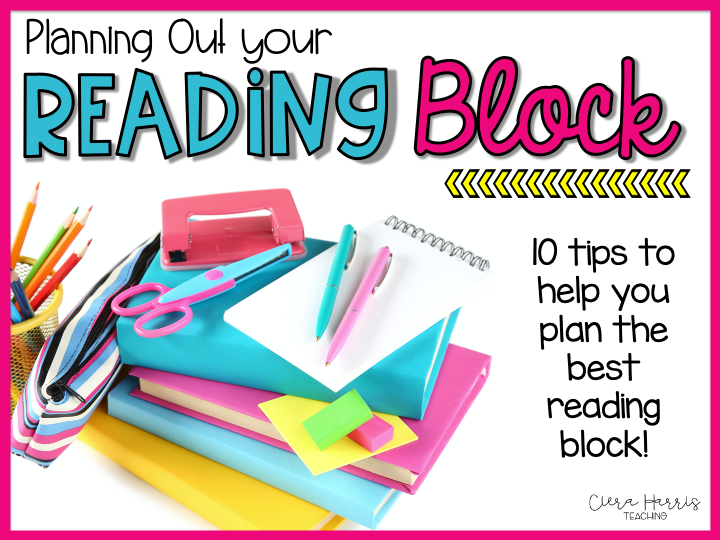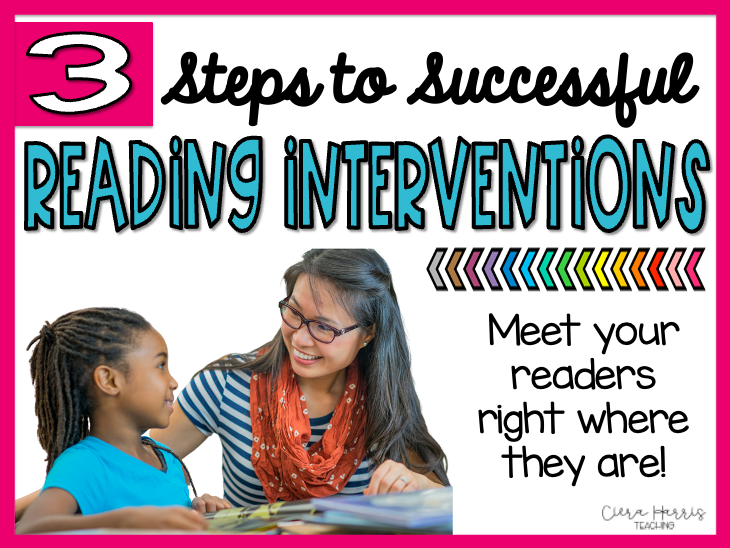It’s a back to school tradition. Teacher head to Target to grab the latest finds in the Target Dollar Spot, they put up their bulletin boards, and then they sit down to design the best reading block they can. It’s inevitable. No matter how grand of a year we had last year, each year teachers reschedule and replan to make this year’s reading block even better. So what is the best schedule for a reading block? How do you plan out your minutes? Is one reading block schedule better than another? I’ve gathered my 10 best tips for planning your reading block in hopes to help answer all of these viable questions!

Want to watch the video instead? Check it out below! Make sure to subscribe to get updates on all new content!
Reading Block Tip #1: Identify your Goals
Think about the goals you have for the year. What are your core beliefs? Believe it or not, this is the foundation of your reading block. And depending on your grade level, the goals you have for your reading block should/could reflect that. For example, when I taught 3rd grade, one of my biggest goals for my students was for them to become strong in reading comprehension. Because that was a goal of mine for my students, I knew my reading block needed to reflect that directly.
Other goals I had for my class were engagement, differentiation, and meaningful instruction. So how are these also reflected in my reading block? Engagement showed up through the lessons I planned during the whole group instruction time. Differentiation showed up in how I planned my small groups. Meaningful instruction was reflected in how I planned out my small groups and the activities I picked to put in each of the time slots.
It’s important to identify the goals we have for our students and make sure they are the true core of our reading block.
Tip #2: Need & Time Alignment
So what in the world am talking about here? Simple! The needs of the majority of your students should reflect in your reading block. So if you teach in a younger grade and the majority of the students need to focus on decoding skills and fluency, then that is what the majority of the time of your reading block should be devoted to. So again, when I taught 3rd grade and knew that comprehension was a huge need for all of my students, that’s how I determined that I would have a 30-minute whole group comprehension lesson each day.
Trying to focus on everything each day doesn’t work. Know your students, know their needs, and reflect your reading block around it.
Reading Block Tip #3: Include all 5 Literacy Components
But wait, you just said not to focus on everything every day, right? Right! We want to make sure we provide quality instruction over quantity. However, all 5 literacy components (phonemic awareness, phonics, vocabulary, comprehension, and fluency) need to be addressed throughout the week. So when you plan out your reading block, it’s easier and better to plan it out as a week instead of a day by day.
For example, since I knew my class focus (3rd grade) was comprehension and a lot less on phonics and fluency, I didn’t have lessons on those every day. Instead, I incorporated mini-lessons twice a week for those less needed components of literacy. So by the end of the week, yes, I hit on all 5 components. But I was still able to focus on quality instruction over daily quantity.
Want a FREE planning template to help you answer some of these questions we’re walking through today? You can grab it right HERE for free!

Tip #4: Identify Your Influencers
Influencers are the pieces of curriculum, programs, activities, that you MUST do inside your reading block. What are the mandates that you have coming from your administration? What do you HAVE to do within the time period of your reading block? Identifying these influencers and laying them out in a list help to make sure you’re doing everything NEED to do and get them in.
You might want to have a conversation with your administration about the length of time and what are the minimum requirements for these influencers. Knowing that will help you determine how to devote your time to each influencer. For example, maybe your school mandates the online reading program of Lexia (highly recommend this program by the way!). Ask your admin how much time your students HAVE to be on it. If it’s 60 minutes a week, that’s great to know! Then you can figure out how to get those minutes divided among your week the best way possible in your reading block.
Reading Block Tip #5: Rank the Importance
We all know that time is our enemy. We need more of it, especially to teach reading! It’s important to list out EVERYTHING we need and want to do in our reading block and then rank each item in relation to its level of importance. Things on your list might include interactive read-aloud, mini-lessons, independent reading, small groups, whole group lessons, word work, vocabulary, etc.
Make a list of absolutely every little thing you want to put in your week. Then for each item give it a ranking based on how important it is to get done. You can rank things by giving them a number from 1-5 or a star system. Whatever works for you. Once you’re done, you’ll be able to see what you NEED to include more of, what you need to include less of, and how many minutes you need to devote per activity/focus.
Want an example of how I plan out my 90-minute reading block? Here you go! A few things about this schedule: IA stands for Instructional Assistant, DC stands for digital content (computer programs), and playlists are a must-do/may do type list for students.

Tip #6: Transition Time
This is an easy tip but an important one to remember. Transitions take time. Whether they are transitions at the beginning of reading to unpack, end of reading to pack up, moving from one activity to another, stations to stations, etc. It’s important to calculate the reality of how much time transitions take. Subtract that time away from your overall reading period time. This allows you to know exactly how many minutes you actually have to devote to true instruction and activities. So if I have a 90-minute reading block but I know I have 7 minutes of transitions in there, then I plan my reading block for 83 minutes!
Reading Block Tip #7: Try and A/B schedule
A/B schedules are a great way to break the mold of doing the same thing every single day. They also help you find more time to get more activities and focuses in. What I mean by A/B schedule is that Monday and Wednesday would be designed and the same while Tuesday and Thursday are designed differently and are the same. You can see my example in my photo above of my A/B schedule that I used.
Tip #8: Take Yourself Out of the Rotation
Yup, I said it! If you are doing reading centers or stations, you do NOT need to be an actual station. Being one completely limits you. The purpose of you doing small groups is to give students support and instruction for what they need to focus on at that moment. If you keep your groups the same and simply rotate them, there’s no flexibility in how you see your students and support them.
By taking you out of the rotations, you’re more able to pull groups based on what students need right now! If you have two students who need a reteach, then you pull just those two students. If you need to do a guided reading group and it takes 25 minutes, then that’s fine. If you need to do a 10-minute strategy group – then do it! Your purchase when giving you more freedom becomes truly helping students in the moment rather than just being a part of a schedule. It’s freeing – give it a try!
Reading Block Tip #9: Keep Centers Consistent
Centers take time to get into a groove and one of the best ways to ensure they work smoothly is to keep them consistent. Identify the goals you have for each station or center and keep that goal the same throughout the semester or year. For example, center #1 will always be reading comprehension, and every time they come they will have a text with a graphic organizer to complete. Or center #2 is always going to be word work and they will have choices of simple but engaging activities to pick (that don’t ever change) for the to work on based on the week’s focus.
By keeping your centers consistent, you’re eliminating the time it takes to explain everything every week. Students know what to do and where they go to do it. And by taking your out of the rotation (like we mentioned above) your groups will rarely need to change! Keep it consistent!
Tip #10: Try Purposeful Groups vs. Centers
Okay, I’m leaving you today with a big one to think about. Do you REALLY need to do stations or centers? Why not try ‘purposeful groups’ instead? Not sure what I mean, head up and take a look at my 90-minutes reading block visual example I posted above. You’ll see that during small group time (center time) I have my lower students in a group working on a specific focus, my on-level group working on a specific focus, and the same for my higher-level group.
How can you support your students better by providing focused small groups instead of rotation centers? Just something to think about!
Did you find a tip or two that’s helpful today? I hope so! Remember that there’s no ‘perfect’ reading block. Even mine has flaws. There’s not enough time and always too much to do and too many needs for our students. Just think about the steps above and the questions you need to ask yourself. Keep your students at the focus of your reading block and you’re good to go.





